ASM Metals HandBook Vol. 14 - Forming and Forging
Подождите немного. Документ загружается.

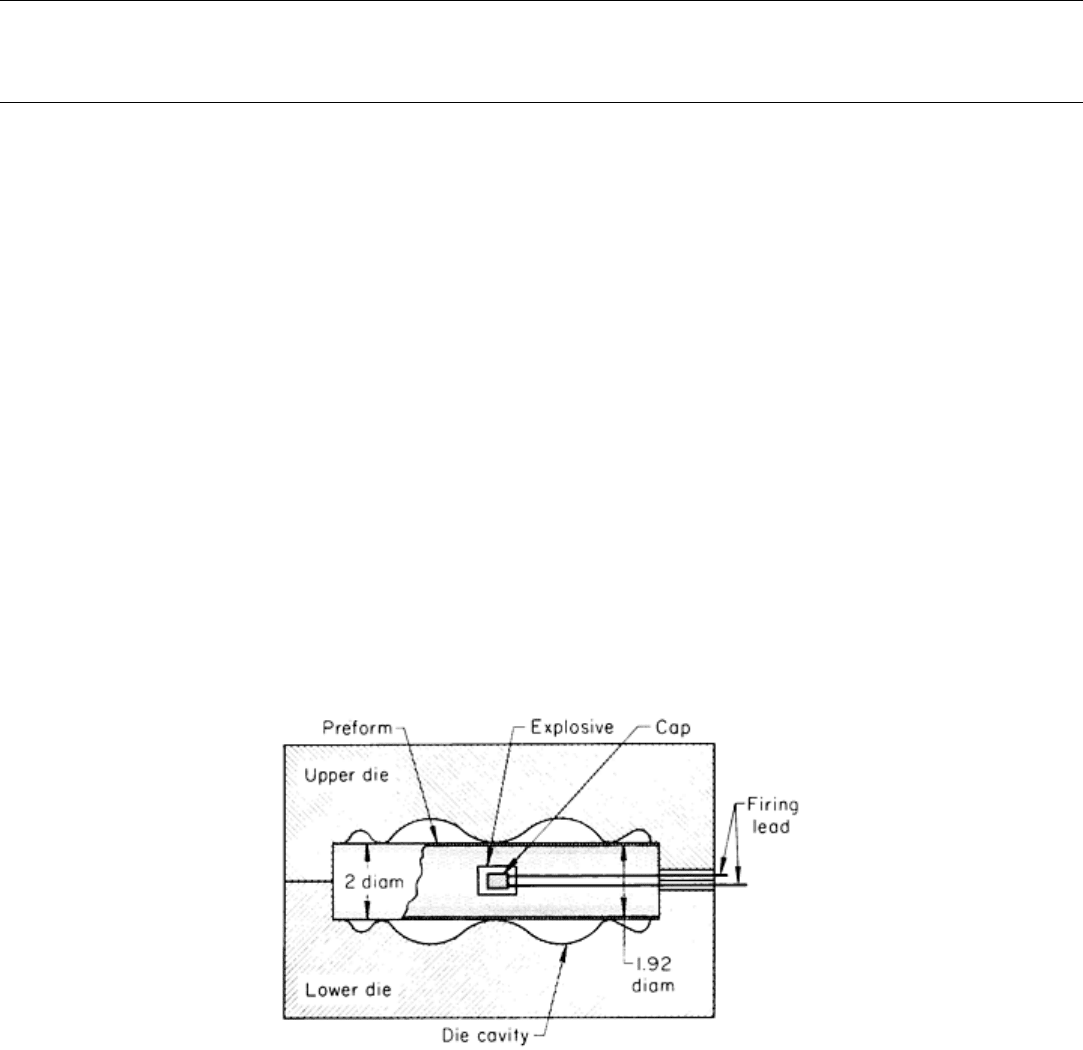
through each pass. This profile enables the designer to determine whether too much work is being performed at a
particular pass.
The numerical information compiled by the computer can be employed in numerically controlled machining operations to
ensure that rolls are accurately produced. The computer also aids in the setup of the rolls on the machine by specifying the
size and locations of the required shims and spacers. All this information and data can be stored for future use and
reproduced whenever necessary.
To design the rolls, information about the roll forming machine, the cross section of the final shape, and the initial
forming sequence are entered in the computer program. The computer numerically defines the coordinates of each corner
and displays on the computer terminal the profile of the part at each pass as well as various perspectives of the flower
diagram. Input changes can be made to vary the material flow through the roll forming machine so that optimum flow is
achieved. Computer output includes flower diagrams, drawings of the cross-sectional shape, drawings of the rolls, and
tabular data defining the material and rolls. A computer can also produce the tapes used in the manufacturing of the rolls
on numerically controlled machines.
Explosive Forming
Revised by A.E. Doherty, Explosive Fabricators, Inc.
Introduction
EXPLOSIVE FORMING changes the shape of a metal blank or preform by the instantaneous high pressure that results
from the detonation of an explosive. This article is concerned only with the explosives generally termed high explosives,
and not with so-called low explosives.
Metal tubing up to 1.4 m (54 in.) in diameter in lengths up to 4.6 m (15 ft) have been formed using the explosive forming
process. Diameters of 1.4 m (54 in.) or less can have lengths of up to 9.1 m (30 ft).
Typical domes constructed of 6- to 12-piece gore sections fabricated from explosively formed metal can measure up to
6.1 m (20 ft) in diameter. Russian engineers have used the process to fabricate gore sections for a 12 m (40 ft) diam dome.
Systems used for explosive-forming operations are generally classified as either confined or unconfined. This article will
primarily deal with unconfined systems.
Confined systems (Fig. 1) use a die, in two or more pieces, that completely encloses the workpiece. The closed system
has distinct advantages for the forming of thin stock to close tolerances, and it has been used for the close-tolerance sizing
of thin-wall tubing. However, confined systems are generally used only for the forming of comparatively small
workpieces because economic feasibility decreases as the size of the workpiece increases.
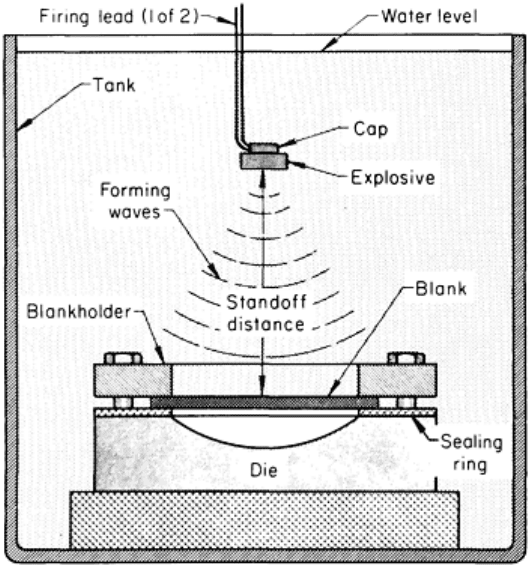
Fig. 1 Confined system for explosive forming. Dimensions given in inches.
Unconfined Systems. In an unconfined system (Fig. 2), the shock wave from the explosive charge takes the place of
the punch in conventional forming. A single-element die is used with a blank held over it, and the explosive charge is
suspended over the blank at a predetermined distance (the standoff distance). The complete assembly can be immersed in
a tank of water, as shown in Fig. 2, or a plastic bag filled with water can be placed over the blank.
Fig. 2 Unconfined system for explosive forming.
The unconfined system is inherently inefficient, because only a small part of the total energy released by the explosion is
effective as forming energy. The medium in which the explosion occurs plays an important role in determining the
efficiency of the system. Efficiency increases with the density of the medium. Therefore, most explosive forming of large
pieces is done in a medium more dense than air. Water is the most commonly used medium for ambient-temperature
explosive forming. Molten aluminum has been used as the medium in explosive forming at elevated temperature.
Under normal operating conditions, it is best to detonate the explosive charge as far below the surface of the water as
possible. This reduces the amount of water that is thrown by the explosion, and it reduces the amount of energy lost by
venting to the atmosphere the gas bubble that results from the detonated charge. However, there is a depth for a given size
of charge below which additional efficiency will not occur.
The amount of energy or peak pressure delivered can be calculated from standard formulas. A cylindrical charge (or point
charge) is generally located near the centerline of the part and at a standoff distance that is related to the span of the
workpiece over the die cavity. For large parts, it is generally impractical to use a point charge. For example, in forming
large hemispheres or end closures for rocket motors, Primacord--either shaped in a large loop and located close to the
outer periphery of the part or strung in a net form (using a fish net as a suspension device)--is ordinarily used instead of a
point charge. Primacord is a cordlike detonating fuse that consists of a filament of explosive material covered by a
protective water-repellent coating.
The variations in energy level delivered from various shapes of charge are small when the charge is fired in a water
medium if standoff distance is 305 mm (12 in.) or more. When charges are placed close to a blank (within 25 to 50 mm,
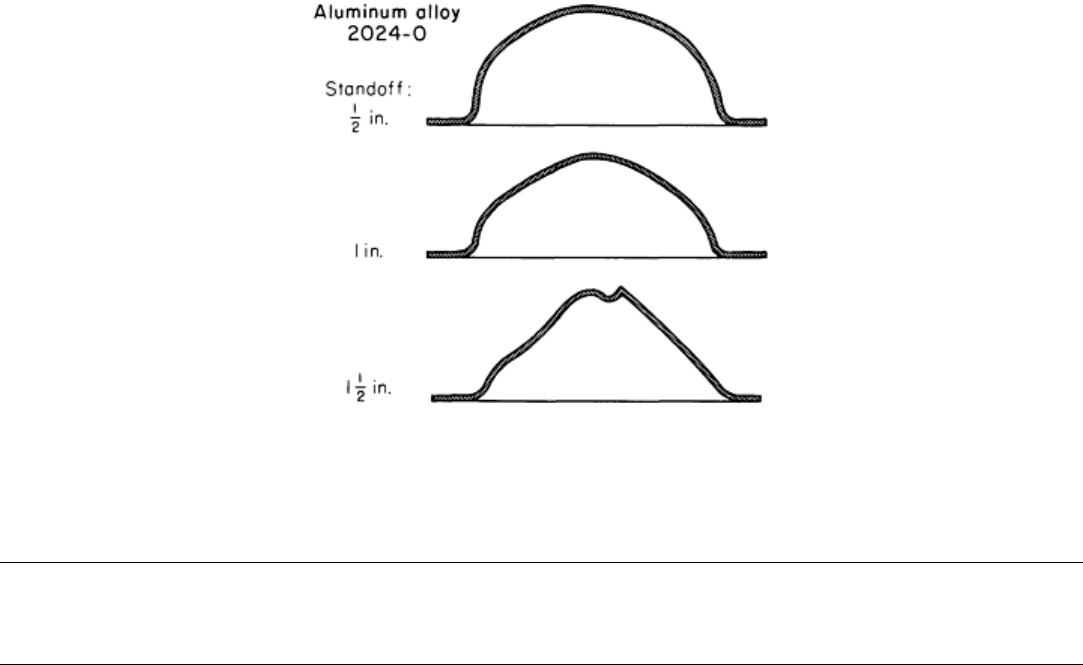
or 1 to 2 in.), energy transfer mechanisms from the explosive to the workpiece change. Figure 3 shows an example of
these effects.
Fig. 3 Cross sections of explosive-formed workpieces showing the effect of sl
ight changes in standoff distance
at close range.
Explosive Forming
Revised by A.E. Doherty, Explosive Fabricators, Inc.
Equipment
The primary equipment for explosive forming in an unconfined system consists of a water tank, a crane, a vacuum pump,
and a detonator control (firing) box.
The water tank must withstand the repeated impacts of the explosive shock without rupturing. Many tanks are
designed to be large enough so that the shocks reaching the walls from centrally placed charges are considerably reduced.
Figure 4 shows the stress in a tank wall as a function of the radius of the tank for a 0.5 kg (1 lb) charge of TNT and a
constant wall thickness of 25 mm (1 in.). These data show that an increase in the diameter of the tank from 1.2 to 12 m (4
to 40 ft) lowers the stress level in the tank wall by only about 26%--from 11.4 to 8.45 MPa (1650 to 1225 psi). At the
same time, the weight of tank-wall material increase tenfold.
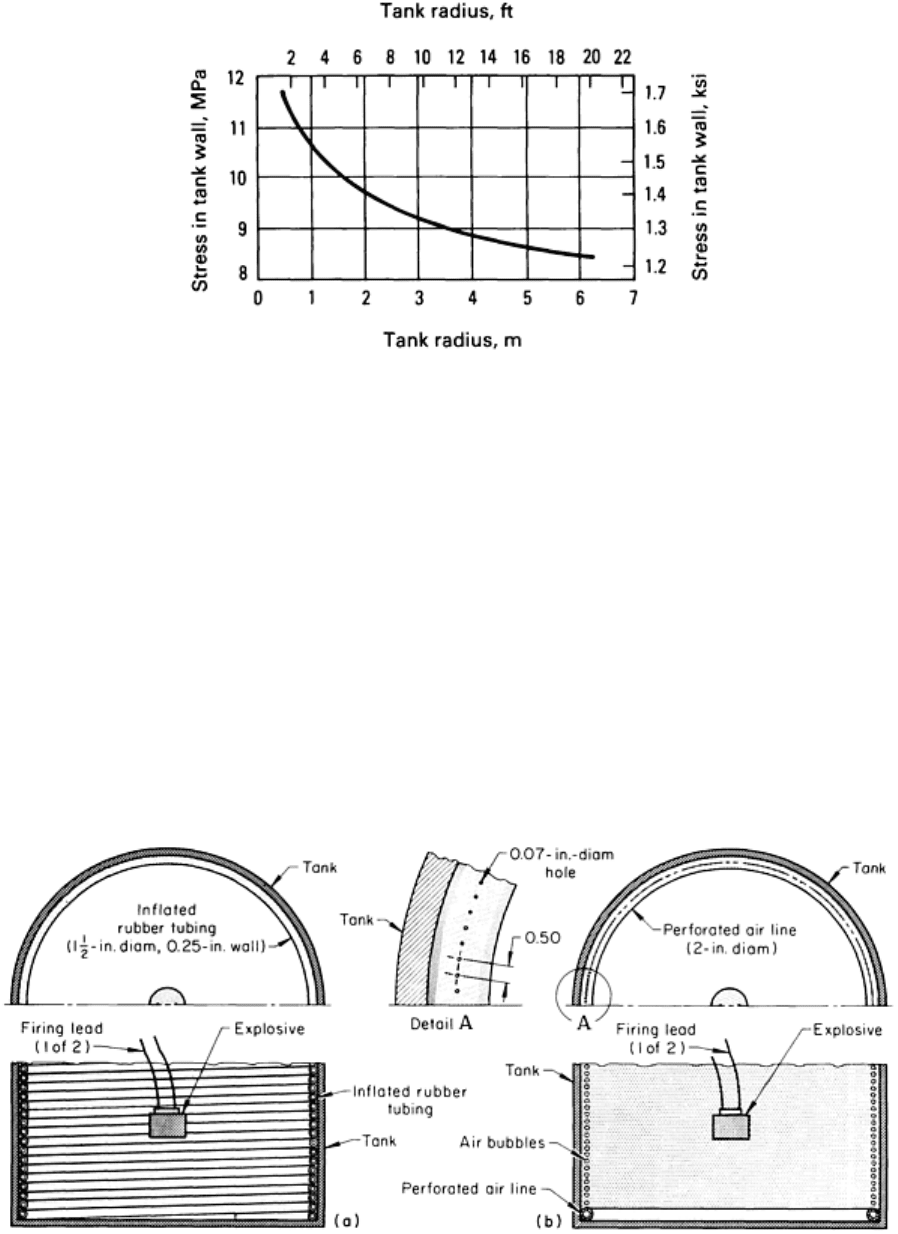
Fig. 4 Effect of tank radius on stress produced in a 25 mm (1 in.) th
ick tank wall by the detonation of 0.45 kg
(1 lb) TNT at the tank center.
One of the best approaches to the reduction of tank-wall thickness is to moderate the pressure of the shock wave before it
strikes the tank wall. Figure 5(a) shows the use of inflated rubber tubing for the reduction of stress in the tank walls. The
rubber tubing acts as a cushion; in one application, it provided an 83% reduction in stress. A considerable amount of
tubing would be needed to use this technique in a large tank, and it would be difficult to maintain the position of the
tubing and to prevent damage to the tubing during explosions. The use of an air-bubble curtain as shown in Fig. 5(b)
appears to be one of the best solutions for low-cost water tank construction. To be effective, a uniform and closely spaced
curtain of bubbles must be maintained along the walls of the water tank. The bubble curtain is controlled by the size and
spacing of holes in the air line at the base of the tank and by the air flow and pressure maintained in the line. A maximum
charge size of 0.5 kg (1.1 lb) of TNT has been fired in a 2.4 m (8 ft) diam tank having 12.5 mm (½ in.) thick steel wall, 25
mm (1 in.) thick steel bottom, and a curtain of air bubbles with no visible signs of damage to the tank wall when the
bubble curtain was operating.
Fig. 5 Use of inflated rubber tubing (a) and an air-bubble curtai
n (b) for reducing the stress in the tank walls
induced by explosion. Dimensions given in inches.
The base of the tank must withstand at least as much impact as the tank walls. It is advantageous to place the tank in solid
rock, where possible. A heavy base of reinforced concrete can be used if it is covered by a heavy steel plate to distribute
stress in the concrete evenly, preventing localized high stresses. Shock-absorbing material can be placed between the
concrete and the steel baseplate; a sheet of rubber will provide some stress reduction. The use of a closely coiled, inflated
rubber hose between the baseplate and the base of the tank is also effective in reducing stress; stress in the base can be
reduced by as much as 80% with this technique. The hose should be inflated with only enough air to support the baseplate
and the water head above it; overinflation will increase stress-wave transmission and may result in damage to the hose.
Difficulties in sealing the tank base to the tank wall must also be overcome. In some metal tanks, the joint has been
welded, but not with complete success. Seals of resilient plastic have provided satisfactory results, and they are easy to
repair if a leak develops.
A crane is usually needed to move material around the facility, as well as in and out of the water tank. Ideally, the crane
should be air operated to avoid having electric power lines within the firing area. The required capacity of the crane
depends on the size and weight of the dies to be handled. A jib crane is one of the best systems for handling large dies.
One of the largest portable dies used in an explosive-forming operation weighed 9500 kg (21,000 lb).
A vacuum pump will probably be needed for most explosive-forming operations when parts are formed under water. If
the firing area is to be maintained with a minimum of electric lines, an entire pump operating on water pressure will work
satisfactorily. A mechanical pump driven by an electric motor can be used; the vacuum lines are brought into the firing
area from a remote pumping site. An electrically driven mechanical pump is preferred because it has a considerably
greater capacity than a venturi pump and is more economical to operate. A pump that will not be affected or damaged by
water intake is the best type. These are sometimes called liquid ring pumps. If a conventional vane-type mechanical pump
is used, it is important to eliminate any possibility of water entering the pump. In a high-production facility, where the
application of a vacuum might be unacceptably time consuming, a storage tank in the vacuum line will greatly assist the
operation. If it is deemed necessary to operate an electrically driven vacuum pump in the firing area, it should have
shielded wiring and a sealed motor.
Detonation Circuit. Under ideal conditions, the firing box for the electric blasting caps is the only electric device that
should be permitted in the area where explosives are handled. A firing box should be constructed on the fail-safe principle
so that any malfunction will immediately cause the circuit to be disarmed. The following characteristics are desirable in
the design of a firing box for use in explosive-forming applications:
• The device should be operable only with a key that is carried by the individual setting the charges
• When the device is not armed with the key, this fact should be visually discernible from the work area
• The lead wires to the cap should always be shorted when the circuit is not armed
• When the circuit is armed with the key, both a visual and
an audible warning of its armed condition should be
activated automatically
• A method of checking the continuity of the blasting circuit should be an integral part of the firing box
A schematic wiring diagram for a detonator that meets these requirements is shown in Fig. 6.
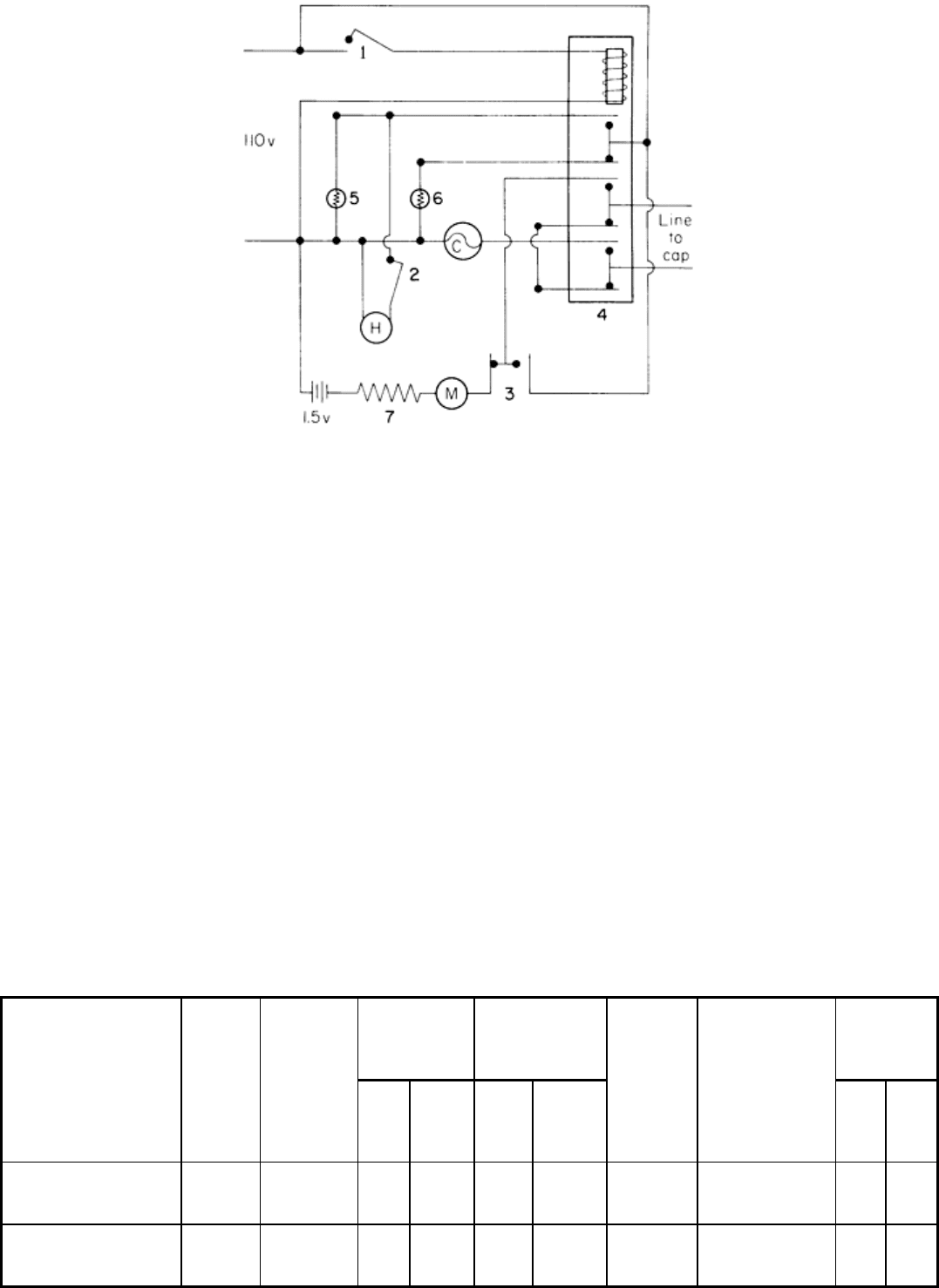
Fig. 6
Wiring diagrams for a safe detonator for explosive forming. 1, key switch (single pole, single throw); 2,
horn switch (single pole, single throw; momentary-off operation); 3, continuity and firing switch (single pole,
double throw); 4, relay (triple pole, double throw); 5, "armed" warning light; 6, "safe" warning light; 7, 10,000
Ωresistor. C, 5 A circuit breaker; H, horn; M, microammeter.
The current for firing the blasting caps can come from a 6 V battery or directly from a 110 V line. If a 110 V line is used,
it is advisable to use a circuit breaker to protect the lines if a short occurs during firing.
Figure 6 shows the circuit for a firing box in the unarmed condition, the condition being demonstrated by current flowing
through the uppermost of the three poles in the relay (4) to the "safe" warning light (6). Switch 1 is actuated by a key
carried by the responsible person. It operates the relay. The upper pole disconnects the "safe" warning light and connects
the "armed" warning light (5) and the horn (H). The two other poles shift to disconnect the short circuit of the line to the
caps and connect its two leads to the firing circuit. Switch 3 is the detonating switch. Before it is thrown, the firing circuit
is completed through the battery and the microammeter for a continuity check of the circuit. When switch 3 is thrown, the
110 V line is connected to the firing circuit and the cap detonates. Thus, the conditions listed above are met.
Explosive substances used in the explosive process have detonation velocities ranging from 1400 to 8380 m/s (4600
to 27,500 ft/s). Additional properties of selected explosives used in explosive forming are listed in Table 1. The
conversion from solid explosive to gaseous products takes fractions of a second and creates temperatures of 3000 to 5500
°C (5432 to 9900 °F) and pressures of 6.9 to 28 GPa (1000 to 4000 ksi) (Ref 2).
Table 1 Properties of selected high explosives
Detonation
velocity
Energy
Maximum
pressure
Explosive Relative
power,
%
TNT
Form of
charge
m/s ft/s kJ/kg
ft ·
lbf/lb
Detonator
required
Storage life
GPa
ksi
Trinitrotoluene (TNT) 100 Cast 7010
23,000
780 262,000
J-2
(a)
Moderate 16.5
2400
Cyclotrimethylene 170 Pressed 8380
27,500
1270 425,000
No. 6 Very good 23.4
3400

trinitramine (RDX) granules
Pentaerythritol
tetranitrate (PETN)
170 Pressed
granules
8290
27,200
1300 435,000
No. 6 Excellent 22.1
3200
Pentolite (50/50) 140 Cast 7620
25,000
950 317,000
No. 8 Good 19.3
2800
Tetryl 129 Pressed
granules
7835
25,700
. . . . . . Special
(b)
Excellent . . .
. . .
Composition C-3 115 Hand-
shaped
putty
8045
26,400
. . . . . . No. 6 Good . . .
. . .
40% straight dynamite 94 Cartridge
granules
4725
15,500
605 202,000
No. 8 Fair 6.7
970
50% straight ditching
dynamite
103 Cartridge
granules
5305
17,400
660 220,000
No. 6 Fair . . .
. . .
60% extra dynamite 109 Cartridge
granules
3810
12,500
715 240,000
No. 6 Fair 4.3
620
Blasting gelatin 99 Cartridge
plastic
7985
26,200
1220 408,000
J-2 Fair 17.9
2600
Bituminous coal D
permissible explosive
. . . Cartridge
granules
1400
4,600 . . . . . . No. 8 Fair . . .
. . .
Primacord, 8.5 g/m (40
gr/ft)
. . . Plastic or
cotton cord
6340
20,800
. . . . . . No. 6 Excellent . . .
. . .
Mild detonating cord,
2.1 g/m (10 gr PETN/ft)
. . . Metal-
coated cord
7315
24,000
. . . . . . Special Excellent . . .
. . .
Detasheet . . . Cut to
shape
7225
23,700
. . . . . . No. 8 Very good . . .
. . .
Cyadyn 3 90 Cartridge
granules
2135
7,000 . . . . . . No. 6 Fair-good . . .
. . .
IRECO DBA-10HV 20 Slurry
(two parts)
3505
11,500
. . . . . . Special Excellent
(unmixed
components)
. . . . . .
Source: Ref 1

(a)
With booster.
(b)
Special engineer's blasting cap.
Auxiliary Equipment. During the operation of an explosive-forming facility, debris will probably collect on the
surface of the water or be distributed throughout the water tank. Skimming equipment, such as that used for swimming
pools, serves well for the removal of material floating on the surface. Material distributed throughout the water must be
removed by filtration. However, any explosive material collected in the water tank will be pumped through the filtration
lines and possibly into the pump, where it may collect and later cause an accident.
In locations where water is plentiful, the tanks are emptied by gravity and refilled frequently; in other areas, the same
water must be reused. The dumping of tank water into sewer lines should be avoided because any explosive suspended in
the water may be trapped by an obstacle in the sewer and accumulate into a concentration that could cause a serious
accident. When an incomplete detonation of the explosive material is detected, attempts should be made to recover as
much of the undetonated explosive as possible for later destruction. The filter material should be handled as explosive
material when it is emptied.
The amount of explosive stored within the facility should always be kept to a minimum and preferably should not exceed
the supply necessary for one day's operation. For the temporary storage of explosives within the facility, small storage
containers can be made from discarded refrigerators. The caps should be stored in one and the explosives in another. The
main storage of explosives for the operation should be at some distance from the facility. Local ordinances regarding
explosive storage and storage containers should always be checked.
References cited in this section
1.
M.C. Noland et al., "High-Velocity Metalworking," NASA SP-
5062, National Aeronautics and Space Administration,
1967, p 183
2.
J.S. Rinehart and J. Pearson, Explosive Working of Metals, Macmillan, 1963, p 19-20, 263-266
Explosive Forming
Revised by A.E. Doherty, Explosive Fabricators, Inc.
Die Systems and Materials
Basic differences between tooling for explosive forming and for conventional forming arise from the type of loading that
the die material must withstand. In explosive forming, high-impact loads transmit shock waves through the metal that
cause unusual stress patterns within the die material; therefore, corners should be eliminated where possible. Shock
loading causes the die to fracture along lines from the corners, rather than through the thinnest section as in static fracture.
Figure 7 shows the modes of fracture for conditions of static and dynamic (shock) loading.
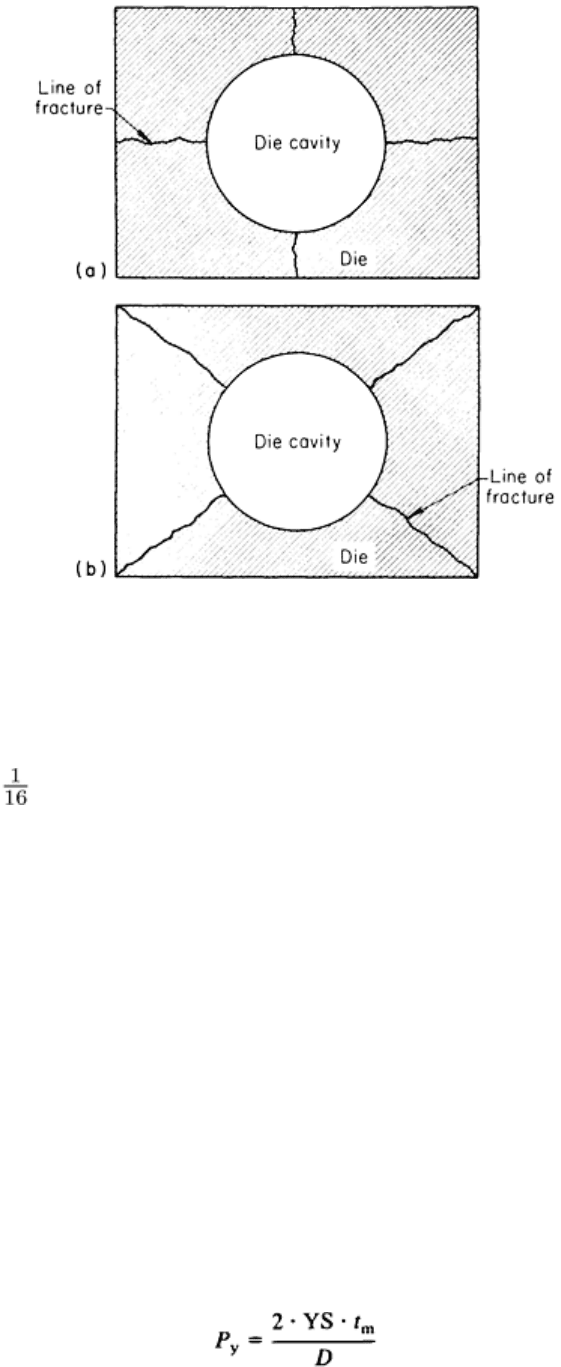
Fig. 7 Modes of fracture of a rectangular die under static (a) and dynamic (b) loading.
Evacuating Ports and Seals. In most explosive forming, a vacuum is applied between the blank and the die cavity. If
possible, some method of sealing should be made an integral part of the die. In many applications, the use of rubber
projecting about 1.6 mm ( in.) above the die surface has provided the necessary seal. Because explosive forming
causes the metal to pick up detail from the die, the vacuum port in the die should be kept small and should be located in a
part of the die where its impression can be removed from the workpiece in a subsequent trimming operation. If this is not
possible, the vent hole should be located so that the dimple that is formed will not be objectionable.
Blankholder Design. A blankholder is generally necessary to prevent wrinkling of the metal as the blank is drawn into
the die. The size of the blankholder and the clamping pressure needed depend on the type of metal being formed. With a
soft metal, such as annealed aluminum, very little blankholder pressure is needed; hard metals, such as stainless steel,
need high pressures to prevent wrinkling.
Bolts or heavy-duty C-clamps are often used to clamp the blankholder to the die. Hydraulic clamping jacks are usually
efficient in the forming of materials such as aluminum that do not need high clamping forces for the blankholder.
In applications in which the parts to be made are concentric and the forming is to be done in air, it may be possible to
eliminate the blankholder. A taper-wall die has been used for forming cones, where the blank is situated on a taper
leading into the die. This technique can provide savings when above-ground operations are used.
Die Design Calculations. Typical design calculations for cylindrical dies are as follows (Ref 2). To determine the
explosive load, the properties of the material to be formed are used. It is first necessary to determine the yield pressure:
where P
y
, is the yield pressure, YS is the yield strength, t
m
is the material thickness, and D is the diameter. Next, the
equivalent static pressure is found:
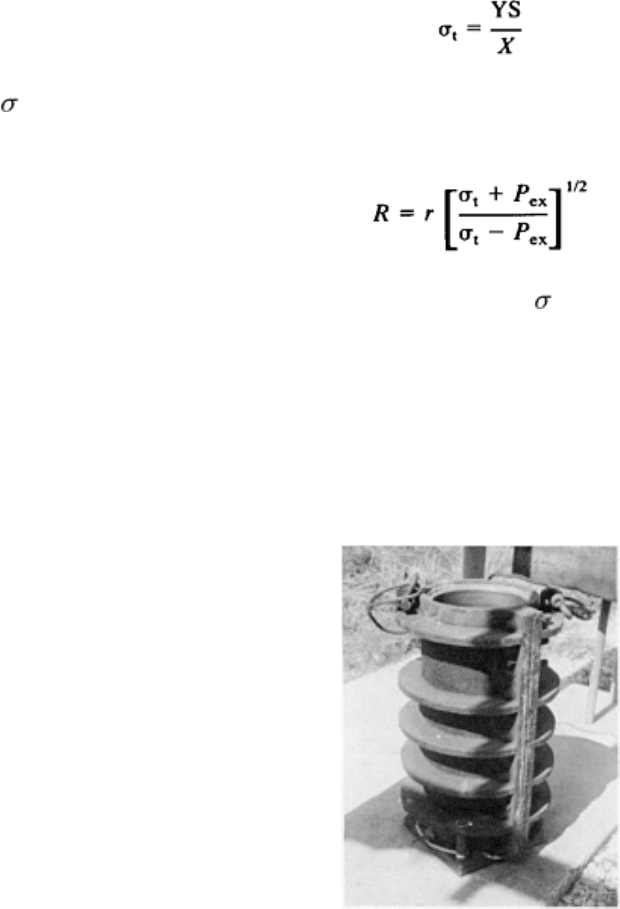
P
ex
= KP
y
where P
ex
is the equivalent static pressure to size explosively, K is the forming factor (average K value is 3 to 20,
depending on the complexity of the part being formed), and P
y
is the yield pressure.
To find the die wall thickness, the design stress is first determined:
where
t
is the design stress, YS is the yield strength, and X is the safety factor (X value is 4 to 6). Then, using Lame's
formula:
where R is the outside radius of the die, r is the final part radius,
t
is the design stress, and P
ex
is the equivalent static
pressure to size explosively. Therefore:
W
t
= R - r
where W
t
is the die wall thickness, R is outside radius of the die, and r is the final radius of the workpiece. The die wall
thickness calculated by the above equations can be further reduced by the use of stiffening ribs (Fig. 8).
Fig. 8
Explosive forming die with stiffening ribs that was used to size more than 1500 stainless steel tanks.
Source: Ref 3.
Materials for Solid Dies. Solid dies made from heat-treated alloy steel maintain contour, surface finish, and
dimensional accuracy for a relatively long time. To avoid brittle fracture under overloads, a maximum hardness of 50
HRC is desirable.
Where the need for long life and good surface finish does not justify the cost of alloy steel dies, low-carbon steels such as
1010 or 1020 may be good alternatives. In practice, a light coat of lubricating oil over the steel die surface after each
forming operation will provide sufficient protection from rusting. In addition, steel dies should be dried and coated with
oil at the end of each day's operation. A castable alloy containing about 95% Zn and small amounts of aluminum and
manganese has been widely used when the production quantity does not exceed 100 pieces.
